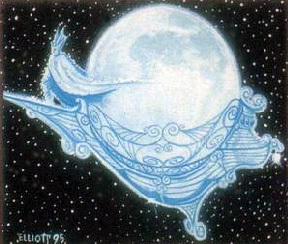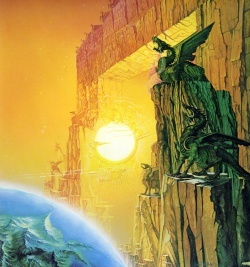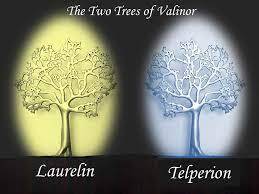Blind Read Through: J.R.R. Tolkien; The Book of Lost Tales, part 1, The Tale of the Sun and the Moon, part 2

“Everywhere did its great light pierce and all the vales and darkling woods, the bleak slopes and rocky streams, lay dazzled by it, and the Gods were amazed. Great was the magic and wonder of the Sun in those days of bright Urwendi, yet not so tender and so delicately fair as had the sweet Tree Laurelin once been; and thus whisper of new discontent awoke in Valinor, and words ran among the children of the Gods, for Mandos and Fui were wroth, saying that Aulë and Varda would for ever be meddling with the due order of the world, making it a place where no quiet or peaceful shadow could remain; but Lórien sat and wept in a grove of trees beneath the shade of Taniquetil and looked upon his gardens stretching beneath, still disordered by the great hunt of the Gods, for he had not had the heart for their mending (pg 189).”
Welcome back to another Blind Read! This week we conclude the Tale of the Sun and the Moon, and while doing so, we’ll talk about worldbuilding, and Tolkien’s penchant for detail.
We left off last week with the Valinor getting the fruit of knowledge from Laurelin and seeing that it held the light of the tree that once illuminated Valinor. It is a revelation for the Valar, but they still don’t have any way to make the illumination more global.
They contemplate for a bit while until Aulë takes Tulkas’ earlier idea:
“‘Then said Aulë: ‘Of this can I make a ship of light – surpassing even the desire of Manwë.’ (pg 186)”

Thus Aulë created the sun, and it sailed through the sky, illuminating the world, but “Ever as it rose it burned the brighter and the purer till all Valinor was filled with radiance and the vales of Eúmáni and the Shadowy Seas were bathed in light, and sunshine was spilled on the dark plain of Arvalin, save only where Ungweliantë’s clinging webs and darkest fumes atill lay too thick for any radiance to filter through (pg 188).”
They realized they had created an issue, a sun that never truly set, and the light bathed the world. One of the most central tenets of Tolkien (if you’ve read anything he had written) is that there can’t be light without darkness. The Valar recognized this as they saw that too much of a good thing (I.E., perpetual sun) eventually hurt them. They harkened back to when they had the two Valinor trees created with Ilúvatar’s themes; they sang into existence and decided to do something with the light of Silpion (the twilight tree).
Lórien sang to Silpion and touched the wound where Ungoliant sucked the life from it, and that little bit of music stirred something in the tree and got the sap moving. A single rose bloomed, holding the silver light of Silpion.
Lórien, proud of their work, “would suffer none to draw near, and this he would rue for ever: for the branch upon which the Rose hung yielded all its sap and withered, nor even yet would he suffer that the blossom to be plucked gently down… (pg 191).”

Both of these instances I wrote about earlier matter when we talk about the Valar. They show their ignorance, Hubris, and their childishness. Aulë has no problem stealing ideas from Tulkas and making them his own, notwithstanding that he also claimed to create the Sun. However, that was a group effort to stumble upon a solution, and Aulë only built the last portion, which would sail across the sky.
Meanwhile, the pranks of Melkor lead him to be imprisoned, but because the other Valar are creating and not pranking, they are above reproach.
Tolkien, as Ilúvatar, created these Vala in his image, just like the Christian God. By extension, these attributes were transferred to the Children of Ilúvatar, the Elves, and Men (technically, the Dwarves were created by Aulë, so they wouldn’t be considered one of the Children).
We also see the avarice of Lórien, guarding the Rose of Silpion, not letting anyone else get the benefits out of fear that they would destroy it. This reminds me of a child playing with a toy they don’t allow their friends to touch. Predictably, the branch holding the rose withers, and the rose falls from the tree, and they use the rose to make the Moon.
The result is the creation of the Sun and the Moon and the alternating cycles of celestial illumination. Tolkien matched the movement of these ships sailing the ether to our own, making his mythology nearly complete.
We’ve mentioned before that his main goal was to create a mythology for England, and at this point, he had his early history created. The Elves who went to Middle-earth have an account of murder and violence in their journey to find solace, and humans are yet to be born.
Tolkien puts both sun and night with the corresponding feelings they contain:
“‘and in memory of the waxing and waning of these Trees for twelve hours shall the Sunship sail the heavens and leave Valinor, and for twelve shall Silpion’s pale bark mount the skies, and there shall be rest for tired eyes and weary hearts (pg 191).”

The Sunship brings hope and opportunity, but if that hope and desire fail, or if one were amidst the trials, Silpion’s bark will rise in the Sunship’s place and give melancholy solace.
There is only one more point that Tolkien has to hit before he has his early mythology complete. The story of the world’s creation, moving into the first age of Middle-earth, needs one more step: to hide away the gods from the mortals before they are born.
Join me next week as we move to the penultimate chapter, The Hiding of Valinor.



